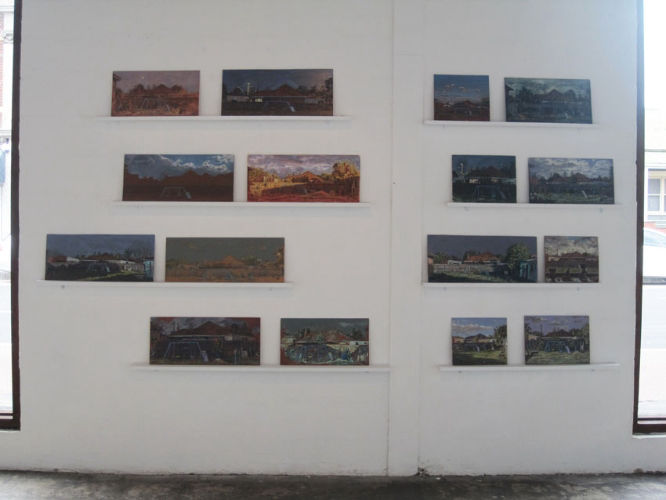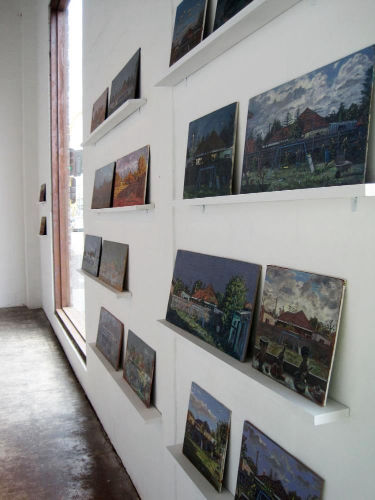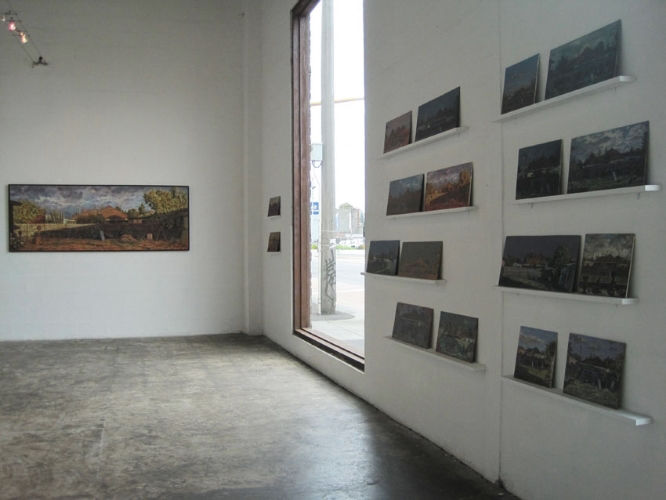


This exhibition was a group show with Gina Kalabishis, Shannon Smiley and myself at Chapman and Bailey Gallery in Abbotsford, Melbourne in 2012.
See essay below to learn more.
These paintings are an ongoing series. The whole series is a slow evolution of mediums and surfaces and experiences. Basically a task I set myself knowing its not complete till I've exhausted the subject. Simply the subject keeps dragging me in. In October of 2016, I held an exhibition in my home in St Albans titled "Swing High, Swing Low" showcasing the complete body of my work.



A trilateral symmetry exists between these three painters Paul Borg, Gina Kalabishis and Shannon Smiley. First uniting under geography and trajectory of practice, this collaboration fecundates ideas of the uncanny into our domestic Australian landscape. Seemingly steeped in the more romantic and traditional styles of composition, these artists have sought to break beyond such forms to sit upon a precipice of the real and the imagined suburban life. As a result, these skewed compositions give the effect of being lost in what should be familiar Australian environments of our objects, our plants and our homes. Borg cites Max Meldrum’s painting ‘Picherit’s Farm’ (1910) as a source of inspiration for these exhibited works. Similar in aspects of their tonal composition, the pieces speak even stronger as obsessive and repetitive depictions of iconic Australiana[1]. Borg’s works of his own backyard appear to use this repetitious painting as a way of coming to understand his personal shifting atmosphere. Much like artists before him - such as Howard Arkley and his houses or Mr Warhol and his cans - these are investigations into icons at a point of change, where the objects themselves through this repetition appear to be stripped of the original meaning they once had. Expectations of a domestic experience come into criticism with these works; indicators such as the lack of figures and the apparent passing of time all reflect upon this. Borg himself commented that he turned his backyard into a stage set; indeed he has seemed to create a space heavily laden with defined roles, restaged and misdirected from its romantic early years. ‘Still life’ as a subject matter has evolved and transformed throughout modern art. Kalabishis’ works appear to linger somewhere in between the traditional and abstract; anatomical and clinical; the familiar and the fanciful. These compositional concomitances serve to place emphasis on the singular elements of the work, much like the labelling of an anatomical drawing, before considering it as a whole arrangement. Initially connections may be made between ikebana and works of Norman Sparnon[2] that draw us in with the iconic imagery of the Australian flora. Upon closer inspection evocative shapes simultaneously stimulate ideas of sexuality and fertility turning this familiarity into an uncanny visceral interaction. Take for example the work ‘The Mermaid’s Purse’. Initially we pull apart the arrangement for the flowers and meticulously placed branches to reveal, not a native cone or flora casing, but a sharks egg hidden beneath the rushes. The composition evolves beyond traditional ideas of balance and form to open a wunderkammer[3] of juxtapositions between domestic and foreign still life imagery. Bringing with him the landscape traditions of the 17th Century, Smiley’s work speaks beyond the idea of landscape as purely a background. This body of work exists as its own entity, it is a world caught in-between the wild/civilised dichotomy of our Australian landscape. This appears in the same vein as early European immigrant artists to Australia such as Eugene Von Guerard[4] who romanticised outback scenes with a cross-continental hybridity. Similarity these works - with their occasional visual indicators of human life in the form of road, cement, graffiti – appear to be coming to terms with a not yet fulfilled expectations of a suburban scene. Our eyes are unable to latch onto a horizon instead being presented with perpetually overflowing compositions of lush plant life. Taken from photographs these paintings work with ideas of what some would find horrifying (decaying industrialisation) others find inspiring (overgrowth in the city), they appear concurrently entangling and unfamiliar. A duality comes across through each artist’s work that allows for a questioning of the subject matter and our expectations towards these habitual environments. What does one do with being placed in surroundings so conscious of the modern condition? One must greet it and speak a firm truth; ‘We Are Here’.
[1] Max Meldrum produced many works depicting Picherit’s Farm one of which is also in the National Gallery of Victoria – ‘Study for Picherit’s Farm’ (c.1910)
[2] See: Sparnon, Norman, The Beauty of Australia's Wildflowers: Creative Ideas for Japanese Flower arrangement, 1967, Weatherhill.
[3] Wunderkammer: German for ‘Wonder-Room’ often referred to as a ‘cabinet of curiosities’ that displayed rare and fascinating parts of natural history.
[4]Von Gerard was also influenced by the same landscape painters of the 1600’s including Nicolas Poussin and Salvador Rosa.
The web page was started with Mobirise